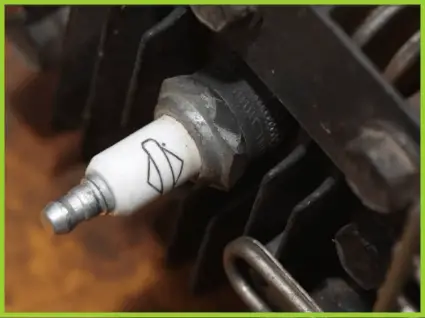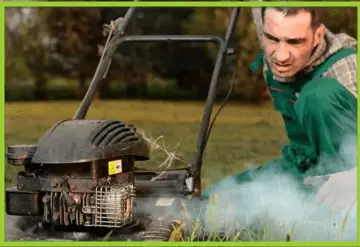When you rely on your trusty lawn mower to keep your yard pristine, there’s nothing more frustrating than encountering problems that disrupt its smooth operation.
One common issue that can leave you scratching your head is a faulty ignition coil.
In this post, we’ll delve into the symptoms of a bad ignition coil on a lawn mower, helping you diagnose and resolve this problem efficiently.
Let’s jump in.
Symptoms of Bad Ignition Coil on Lawn Mower
1. Engine misfiring
Engine misfiring is a clear indicator that something is amiss with your lawn mower’s ignition system, and a bad ignition coil is a likely suspect.
When the ignition coil isn’t functioning correctly, it doesn’t produce a consistent spark to ignite the fuel-air mixture in the engine’s combustion chamber. This irregular sparking can result in a stuttering or sputtering engine.
You might notice that your lawn mower doesn’t run smoothly, and it may even produce strange noises as it struggles to maintain a consistent power output.

2. Hard starting
Difficulty starting your lawn mower is another common symptom of a failing ignition coil. The ignition coil’s job is to generate a high-voltage spark to ignite the fuel when you pull the starter cord or engage the electric start.
If the coil isn’t working as it should, it might not produce a spark of sufficient strength to start the engine.
You may find yourself repeatedly pulling the cord or turning the key without success, or the engine may start but then immediately stall.
Read Are Lawn Mower Ignition Coils Interchangeable?(Find Out)
3. Stalling Engine
A stalling engine during operation is not only frustrating but also potentially dangerous, especially if you’re navigating rough or uneven terrain.
A faulty ignition coil can lead to engine stalls because it fails to maintain a consistent spark.
This means that as you’re mowing your lawn, the engine may suddenly cut out without warning. Such interruptions can disrupt your mowing routine and even leave your yard looking uneven if they are not addressed promptly.
4. Decreased Fuel Efficiency
Another subtle sign of a bad ignition coil is decreased fuel efficiency. When the ignition coil is compromised, it can lead to incomplete combustion in the engine.
This means that not all the fuel is burned, resulting in wasted fuel and decreased mileage. You might notice that you’re refilling the gas tank more frequently than usual, which can be a costly consequence of a malfunctioning coil.
5. Vibrations and Rough Running
A vibrating or rough-running engine is a noticeable consequence of irregular ignition caused by a bad ignition coil. In a well-functioning engine, all cylinders fire in a precise and coordinated manner.
However, when the ignition coil is failing, some cylinders may not receive the proper spark, leading to unbalanced combustion. This can cause vibrations and an overall rough feeling when operating your lawn mower.
Read Mower Dies When Brake Released(7 Quick Ways to Fix)
6. Backfiring
Backfiring is a dramatic sign of ignition trouble. It occurs when unburnt fuel enters the exhaust system and ignites there, producing loud pops or bangs.
A malfunctioning ignition coil can contribute to this phenomenon by failing to provide a consistent spark to ignite the fuel-air mixture in the combustion chamber.
If you hear your lawn mower emitting these startling noises, it’s a clear signal that you should investigate the ignition system, including the coil.

What is an ignition coil?
An ignition coil is a crucial component in the engine’s ignition system. Its primary role is to transform the low-voltage electricity from the battery into the high-voltage spark needed to ignite the fuel-air mixture in the engine’s combustion chamber.
Diagnosing a Bad Ignition Coil
If you suspect a bad ignition coil, follow these steps to diagnose the problem:
Step 1: Visual Inspection
Inspect the ignition coil for any visible damage, such as cracks, corrosion, or loose connections. Replace it if you notice any issues.
Step 2: Resistance Test
Use a multimeter to measure the ignition coil’s resistance. If the readings are outside the specified range, it’s a clear indication of a faulty coil.
Step 3: The Spark Test
Perform a spark test by removing the spark plug wire and grounding it against the engine. Crank the engine, and if you see a weak or no spark, the ignition coil is likely bad.
Read Lawn Mower Makes Grinding Noise When Trying to Start(Solved)
How do you test a lawn mower ignition coil?
Testing a lawn mower ignition coil is a straightforward process that requires a few tools and careful observation.
Tools Needed:
- A multimeter (for resistance testing).
- A spark tester (for spark testing).
- A wrench or socket set (for coil removal if necessary).
Testing Steps:
- Safety First: Ensure your lawn mower is turned off and the spark plug wire is disconnected to prevent accidental starts.
- Access the Ignition Coil: Locate the ignition coil on your mower. It’s typically near the engine’s flywheel, connected to the spark plug wire.
- Resistance Test: Use a multimeter set to measure resistance (ohms). Connect the multimeter’s probes to the coil’s small terminals (primary and secondary) to measure resistance.
- Spark Test: If the resistance test doesn’t conclusively diagnose the coil, perform a spark test. Reconnect the spark plug wire to the spark plug. Use a spark tester (a tool available at most auto parts stores) and connect it between the spark plug and the spark plug wire.
- Crank the engine, and if you see a strong, consistent spark in the tester, the coil is likely in good condition. If there’s no spark or it’s weak and inconsistent, the coil may be bad.
- Replacement: If the ignition coil fails either test, it’s a good idea to replace it. Consult your mower’s manual for the correct replacement part and follow the manufacturer’s instructions for installation.
Read Troy-Bilt TB110 Won’t Start(9 Common Problems + Solutions)
Do lawn mower ignition coils go bad?
Yes, lawn mower ignition coils can go bad over time due to various factors, including wear and tear, heat exposure, moisture, and electrical issues.
Ignition coils are essential components of the ignition system and are responsible for generating the spark needed to ignite the fuel-air mixture in the engine’s combustion chamber.
If a coil becomes damaged or fails, it can lead to poor engine performance, starting problems, and other issues. Regular maintenance and prompt replacement of faulty coils can help ensure your lawn mower runs smoothly.
How do you know if you have a bad ignition coil or spark plugs?
Distinguishing between a bad ignition coil and faulty spark plugs can be challenging because both can cause similar symptoms, such as engine misfiring, hard starting, and rough running.
Here’s how you can differentiate:
- Ignition Coil Issues: If you suspect the ignition coil is at fault, perform the tests mentioned above. A resistance test and spark test can help confirm if the coil is functioning correctly. If the coil fails either test, it may be the culprit.
- Spark Plug Issues: If you suspect spark plug problems, start by visually inspecting them. Foul or damaged spark plugs can often be seen. Replace any spark plugs that appear worn, fouled, or damaged.
- Additionally, you can swap spark plugs between cylinders to see if the problem follows the plug. If the issue moves with the plug, it’s likely a spark plug problem.
In some cases, both the ignition coil and spark plugs may require replacement if they are old or have been exposed to adverse conditions.
It’s essential to diagnose and address each component’s condition to ensure your lawn mower operates correctly.
Read Husqvarna Weed Eater Won’t Stay Running(FIXED)
How do you test a Briggs and Stratton ignition coil?
Testing a Briggs and Stratton ignition coil follows the same general procedure as testing any lawn mower ignition coil, as outlined in the first answer.
Briggs and Stratton engines are commonly used in lawn mowers. Here are the steps once more:
- Ensure safety by turning off the mower and disconnecting the spark plug wire.
- Locate the ignition coil on your Briggs and Stratton engine.
- Use a multimeter for resistance testing and a spark tester for spark testing. Follow the steps outlined in the first answer for both tests.
- If the coil fails either test, it’s advisable to replace it. Refer to your Briggs and Stratton engine manual for specific resistance values and replacement part information.
Read Briggs and Stratton Auto Choke Bypass(Choke No More)
Final Remarks
A bad ignition coil can disrupt the smooth operation of your lawn mower, but being aware of the symptoms and diagnosing the issue promptly can save you time and frustration.
If you experience any of these symptoms, it’s essential to address the problem quickly to keep your lawn mower running in top condition.
Read How to Remove PTO Clutch Bolt(In 5 Quick Steps)
FAQ
Can I replace the ignition coil myself?
Yes, replacing the ignition coil is a relatively straightforward task. However, if you’re not confident in your mechanical skills, it’s best to consult a professional.
Are there any preventive measures to avoid ignition coil issues?
Regularly cleaning and servicing your lawn mower, including the ignition system, can help prevent ignition coil problems.
How often should I replace the ignition coil?
The lifespan of an ignition coil can vary, but it’s recommended to replace it every 2-3 years or as soon as you notice any of the symptoms mentioned in the article.
Can a bad ignition coil damage other engine components?
Yes, a failing ignition coil can lead to unburnt fuel entering the exhaust system, potentially damaging the catalytic converter and other engine components.
What is the cost of replacing an ignition coil?
The cost of an ignition coil varies depending on your mower’s make and model. On average, you can expect to pay between $20 and $50 for the part, excluding labor if you hire a professional.




